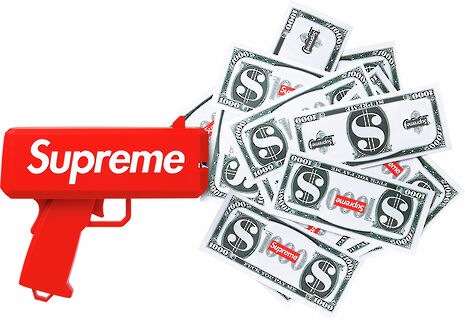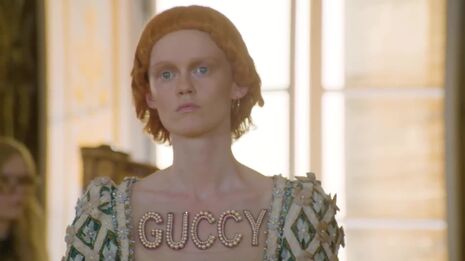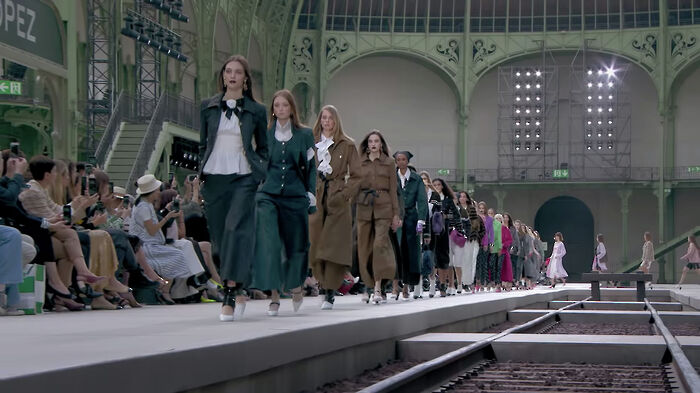Counterfeit: counterculture to couture
Gabriel Humphreys tracks the rise and fall of counterfeit fashion, from a rebellion against the fashion industry to another hot trend on the runway.

In September 2017, models at Gucci’s Spring/Summer show hit the runway with clutches and bags emblazoned proudly with“Guccy”. That season, the same five letters were found splashed across shoes, bags, jumpers and t-shirts. This was far from a misprint, but instead a mocking of the repeated imitation of the brand by counterfeiters, and their attempts to avoid legal action by altering the logo with misspelling. It seems that counterfeiting, once the bane of the fashion industry, has now become couture’s rather odd bedfellow. To trace our current obsession with counterfeit culture, we first need to get back to its roots.
The practice of counterfeiting is hardly new – currency counterfeiters are mentioned in Dante’s writing in the 13th Century; and, the desirability and cost of high-end fashion has also spawned knock-offs and duplicates since the beginning of couture as we know it. In fact, Christian Dior himself was often known to sell off his old patterns to companies that would then make lower quality, cheaper versions of his meteorically successful garments. A culture of fakes became so established that in 1951 the Musée de la Contrefaçon was established in Paris, and now holds nearly 400 counterfeited items.

The real upsurge in counterfeit designer clothes began in the late 70s, with the rising popularity of designer jeans – suddenly overt labelling and brand identity were galvanised into an immediately recognisable reputation, the most enduring being Levi’s. In what is one of the most iconic and provocative adverts of the 80s, Levi’s 501s became instantly and inextricably entwined with a nonchalant bad-boy sexiness as a buff male model undresses calmly in a launderette. Trusted quality merged with a fully exploited marketable image, they weren’t just long-wearing denim, they were cool and they were sexy, and so the people who wore them were too. Thus the craze for designer jeans was born, with Levi’s leading the charge. But these jeans still cost £20–30 (around £60–90 today), and counterfeit pairs with suitable labels sprung up as a logical and economical alternative.
Counterfeit items not only offered an opportunity to connect with designer goods, but also to undermine and mock the very conventions and qualities that define them. Put simply, knock-offs gave the average consumer a chance to deny couturiers a monopoly over their goods. Brands, so desperate to protect what is seen by many as their petty reputations, have gone as far as burning their old clothes to avoid “dilution” of their brand identity and devaluing their image. Carefully copied items became a rebellion, a convenient and cost-effective way to give big fashion business the finger, while still appearing to abide by trends. In a bizarre way, owning items of fake fashion became linked with the rebellious subculture of the ’90s, but kept a mainstream cleanliness. You could own a fake Louis Vuitton bag, and it was simultaneously highly fashionable and a little bit ironic.

In more recent times, the prevalence of streetwear has given rise to even more opportunities for counterfeiting. The rapid pace of change within streetwear trends leaves those wanting to keep up often out of pocket, finding themselves with wardrobes full of garments that have by then passed out of fashion and are no longer sought after and fought over. This lack of need for lasting garments combined with the poor quality of many knock-offs makes them an ideal alternative that remains attractive to the buyer and the consumer, especially considering the intense and often expensive competition when attempting to obtain streetwear releases through legitimate channels. There is something appealing too about the ease of slapping a logo on an item of streetwear – the attraction of many items is simply the brand, not their build quality or construction as might be seen with couture. Indeed such is the desire for logo-driven items that a simple search of eBay allowed me to find a cash gun and ski mask sporting the undeniably pervasive Supreme emblem, and all of which were selling for well under the expected price point for that brand’s limited release items.
This ease of access to fakes reveals one of the key elements of the modern practice of counterfeiting: online markets. Online markets have been a haven for those selling counterfeits. Many brands, as well as trades standards agencies across the world, look to wholesale businesses such as the online marketplace Alibaba. On such websites huge numbers of fairly obvious counterfeits can be found, especially trainers. On one such site, I saw some blatant copies of Nike, Yeezy, and Balenciaga sneakers on just the first page of the Men’s Trainers section, sometimes with reference to the brand, and sometimes with a suspicious “no logo” as the first part of their description.

Retail websites play their part too, and eBay is chief among them. Listings are often very carefully worded – eBay has far harsher filters for what can and can’t be listed, and will punish sellers it deems them to be deliberately deceiving buyers. But, if you know what specifics to search for, there is really no challenge. Although, eBay has recently introduced eBay Authenticate, a tool to verify the original status of branded luxury goods, meaning that those on the lookout for genuine items are not left with knock-offs, counterfeiters are still able to sell copies, just no longer masquerading as the real thing. Currently, a search for horsebit loafers and slippers revealed within the resulting listings a pair of fake Gucci slippers – not listed with the brand’s name, but undeniably a copy of the original. At £25.98, when the real thing costs £625, there is hardly a contest. I also manage to find “Balenciaca” sock trainers for £13.99, intended to replicate Balenciaga’s own that come in at a cool £540.
Etsy also makes a surprising appearance as a marketplace for counterfeit items – accessories are the primary counterfeit items to be here, as well as customised items. After all, every person who owns a printer can transfer paper irons logos onto t-shirts. In spite of a heavy online presence for counterfeit goods, physical stores still continue to thrive around the world, often through markets and street stalls, with some entire districts and malls dedicated to copies of designer couture and streetwear labels.
Sometimes counterfeit items are botched homemade jobs, sometimes they’re made in the very same factories as the real thing with offcuts or with their label unattached, but no matter their origin, their somewhat tricky ethical situation remains the same.
The simple fact is, knock-offs are not as easy to combat as it might seem. Logos are protected by Trademarks, essentially legally enshrined assurances of the origin of a product. Therefore, any fake items bearing the actual logo of a company can and will be seized by authorities, and the sellers prosecuted. But, if even a small portion of the logo is changed, then the power of the Trademark is lost, hence “Balenciaca”, and the lack of logos on so many knock-offs. Protecting the actual design of apparel and accessories then, comes down to intellectual property – the legal rights under which creative enterprises, music, film, literature, are all protected. Patents, often used for inventions and many consumer products, simply take too long to process and by the time the patent was approved on a gown, it would already be out of fashion. The only option then, is claims under copyright, and here is where the whole issue gets thrust into the fierce debate over the status of fashion as an art form.
“Knock-offs are part of the system which drives constant innovation and creativity within fashion”
Copyright laws protect the creative expression of millions of designers, musicians, writers and creatives around the world, and are a particularly powerful tool in allowing small creative industries to thrive, without the threat of big business simply skimming off the best ideas and rehashing them as their own. Unfortunately though, as fashion serves a practical purpose, it is denied this right to protection. The shape, cut or construction of a dress does not fall within the narrow categorisation of creative expressions deemed to require this kind of protection – it is not essentially an artistic practice.
This comes from an old-fashioned and narrow-minded view of fashion: that it is frivolous and inartistic. In the United States there has been at least one House Judiciary Committee hearing that included testimony from designers about their need for protection under copyright, and in which the Representatives present seemed not to understand the designers and openly disagreed with their statements that fashion design should be considered a method of creative expression in its own right.
Beyond this creatively problematic issue, there are also the obvious economic impacts on the fashion industry. The value of worldwide trade in fakes was estimated to be $509 billion in 2016, representing 2.5% of all global imports. This represents an enormous 38% of the value of the legitimate fashion industry as a whole, and brands have long been catatonically angry about large counterfeiting operations with many having pursued legal action, though it often leads to few tangible results.

The sheer volume of knock-offs and counterfeits, as well as the underhand tactics used in their sale and distribution, mean the problem has remained a thorn in the side of governments losing tax revenue and fashion houses whose carefully maintained brand image takes a hit. And so, in a rather unprecedented move, designers seem to have taken can’t-beat-them-join-them attitude, and perhaps they’re right to.
Gucci’s use of “Guccy” on the runway was a bold one, but this was hardly the first time Gucci has taken advantage of the trend: in May of the same year their cruise collection featured a pearl appliqué with the same “Guccy” slogan, and as early as their Fall/Winter 2016 collection they were painting on “Real” over their logos on handbags in graffiti. While some mocked the design choices on social media, by openly confronting the issue the brand had essentially offered a challenge to counterfeiters — that they didn’t care. By doing so, they undermined the power that fakes hold, and the rebellion against a mainstream that they represent. Other designers followed suit, including Diesel opening a pop-up store selling products branded “Deisel” on Canal Street, New York’s infamous counterfeiters paradise. Valentino did the same on the streets of London, selling to unsuspecting street-goers and creating a video campaign from the proceedings.
Quite apart from denying counterfeiters the glee of irritating fashion houses, knockoffs bring their own advantages to the industry. Knock-offs are part of the system which drives constant innovation and creativity within fashion, helping create some or the beautiful pieces or artistic creation we see off and on the runway today. The lack of protection for intellectual property in fashion also allows designers to freely take inspiration from and be influenced by the full multitude of fashions across the world, without fear of prosecution. Excluding cases of appropriation, this in turn helps drive the shifting trends on which fashion lives and breathes. As long as we trust designers to be inspired and not to simply lift ideas from the sketchbook of other, both on an individual and cultural level, then this can only help with the constant rejuvenation that couture requires.
In addition, some designers, including OFF-WHITE’s Virgil Abloh, have even acknowledged counterfeiting is a form of flattery, forming part of the massive marketing powerhouse that sells fashion to the world. There is also a simple argument that the economic impacts are not to be felt as keenly as the figures would suggest. Revenue invested in counterfeit and knock-off goods is very unlikely to have made its way to high-end retailers in the end, after all the lower cost remains the most attractive aspect of the whole industry.
In the end, the real winners in the business of counterfeiting are, ironically, the brands who they seek to impersonate. Their name and image are spread, and their popularity and recognisability remains high. Although, their monopoly might not be maintained, any reduction in their profits is surely a drop in the ocean compared with their enormous incomes. The practice has really only led to the design of more profitable creations inspired in turn by their second-rate cousins. The cycle of fashion continues, with inspiration drawn from the most bizarre places. Perhaps couture has finally conceded that imitation is the sincerest form of flattery.
 News / Cambridge bus strikes continue into new year16 January 2026
News / Cambridge bus strikes continue into new year16 January 2026 News / Uni members slam ‘totalitarian’ recommendation to stop vet course 15 January 2026
News / Uni members slam ‘totalitarian’ recommendation to stop vet course 15 January 2026 Science / Why smart students keep failing to quit smoking15 January 2026
Science / Why smart students keep failing to quit smoking15 January 2026 Interviews / The Cambridge Cupid: what’s the secret to a great date?14 January 2026
Interviews / The Cambridge Cupid: what’s the secret to a great date?14 January 2026 Comment / Will the town and gown divide ever truly be resolved?12 January 2026
Comment / Will the town and gown divide ever truly be resolved?12 January 2026










